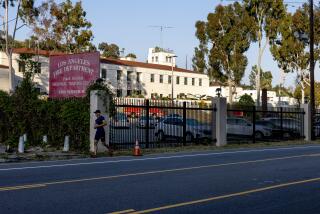Flying Weather : State-of-the-Art Monitoring Equipment Is Plugged In
- Share via
It is no surprise that Southern California, with its 12 months of mild weather, its premium on leisure activities and its approximately 30 airports, has skies that are among the country’s most crowded.
To help many fliers--particularly non-commercial aviators--plan their trips, the Federal Aviation Administration recently installed state-of-the-art weather-monitoring equipment at its automated flight service station on Crenshaw Boulevard in Hawthorne.
The purpose of the flight service station, which opened in 1985, is to help guide errant pilots with directions and offer up-to-date weather reports, said Fred Kelly, manager of the facility, where the staff unveiled its new weather equipment Wednesday.
“It’s pretty sophisticated stuff,” Kelly said, adding that services will become faster and more accurate with the advent of automation.
Vying for the crowded airspace over Los Angeles last year were more than 40,000 locally licensed commercial and general aviation pilots, said Michael Lammes, the station’s area manager.
“Basically we arm pilots with the weather information they need to decide whether they can fly,” Kelly said.
The facility provided weather reports more than 700,000 times by phone and radio recording last year, he added.
In addition to the reports, the station also answers occasional requests to help disoriented pilots determine their location.
“They call in and say, ‘I think I am a little bit lost,’ ” Kelly said. “People probably get lost more often than they are willing to call in. It might be a little bit of an ego thing.”
But usually it is requests for preflight weather information.
Through the new automated system, information is now relayed instantly from a central weather bureau in Kansas City through a chain of similar flight service stations strung across the southwest to the Hawthorne facility. With the new technology, updates on changing conditions are transmitted throughout an information web that connects 61 regional flight service stations across the United States.
There are 44 phone lines on which pilots planning travel routes can call, Kelly said.
The area served by the Hawthorne station includes Los Angeles, Orange and Ventura counties and the area north to Paso Robles, he said.
Last Thanksgiving, an ominous cloud cover and the customary holiday traffic combined to make it a record-breaking service period, Kelly said. One day, they responded to more than 3,000 calls for weather reports, he said.
“I don’t think we’ll bust that mark soon.”
Kelly said it is not unusual for pilots to fly against the recommendations of a technician at the station. Occasionally, a wrong decision has resulted in a crash, he said.
“That is the most frustrating part of the job,” Kelly said. “We hope they take our advice, but we can’t take the keys away from them.”
More to Read
Sign up for Essential California
The most important California stories and recommendations in your inbox every morning.
You may occasionally receive promotional content from the Los Angeles Times.













